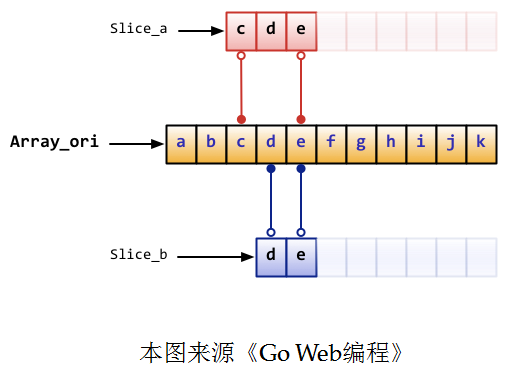Go - 切片(Slice)
阿新 • • 發佈:2017-05-10
什麽 部分 pri 長度 code ron logs 內存 tro
定義
切片本身不是數組,它指向底層的數組或者數組的一部分。因此,可以使用Slice來處理變長數組的應用場景。 Silice 是一種引用類型。
1、定義一個空的Slice
package main import ( "fmt" ) func main() { var slice1 []int //定義一個Slice, []裏面什麽也沒有!! fmt.Println(slice1) }
2、 從數組中幹獲取Slice
func main() { arr := [3]int32{1, 2, 3} // 定義一個數組slice := arr[0:len(arr)] //從數組中取得Slice,從0開始,取到結束 fmt.Println(slice) } //output [1 2 3]
3、使用“make”關鍵字創建Slice
make([]T, len, cap)
[]T - 表示定義那種類型的Slice
len - 表示Slice的長度
cap - 表示Slice的容量;可以省略,即cap=len
s1 := make([]int, 3, 5) fmt.Println(s1) //output [0 0 0]
Slice與底層數組的關系圖

通過關系圖,我們可以得出: Slice_a 長度為3,容量為9, Slice_b 長度為2,容量為8
Reslice
有 Slice 再次生成的Slice。它的特點是:
1. 索引以Slice為準。
2. cap不能超過Slice
3. 索引越界不會從新分配內存,而是直接出錯!!
a2 := [5]byte{‘a‘, ‘b‘, ‘c‘, ‘d‘, ‘e‘} s2 := a2[0:3] fmt.Println(len(s2), cap(s2)) // output 3, 5 s22 := s2[0:2] fmt.Println(len(s22), cap(s22))// output 2, 5
Append 函數

a3 := make([]int32, 2, 4) fmt.Printf("%v, %p\n", a3, a3) a3 = append(a3, 1, 2) fmt.Printf("%v, %p\n", a3, a3) a3 = append(a3, 1, 2) fmt.Printf("%v, %p\n", a3, a3) //output [0 0], 0x114821d0 [0 0 1 2], 0x114821d0 [0 0 1 2 1 2], 0x11489c60
copy 函數
copy(src, dst) - 將dest的切片 copy 到 src, 以兩者之中最短的切片長度為準。
a1 := []int32{1, 2}
a2 := []int32{3, 4, 5}
fmt.Println(a1) // output [1 2]
copy(a1, a2)
fmt.Println(a1) // output [3 4]
copy(a1[0:2], a2[1:3]) // // output [4 5]
fmt.Println(a1)
Go - 切片(Slice)
